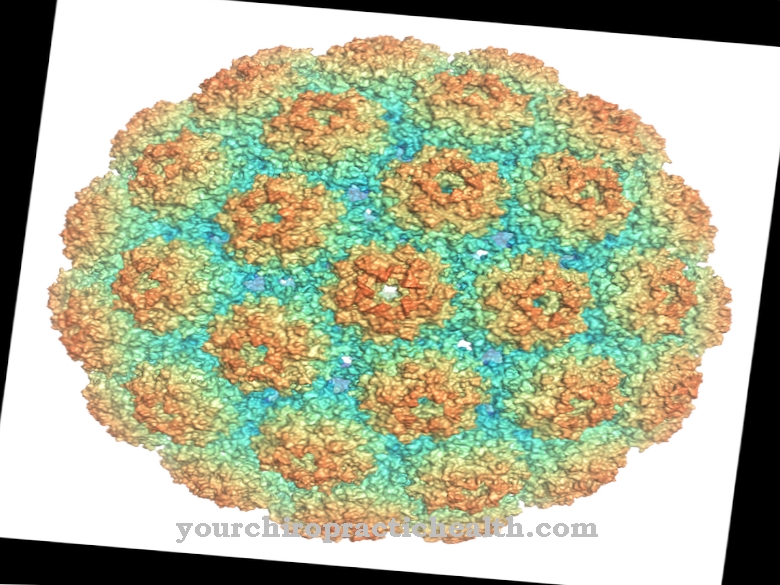As Aspergillus fumigatus a mold from the genus Aspergillus is called. It is considered a high health risk for people with an immunodeficiency.
What is Aspergillus fumigatus?
The Aspergillus fumigatus mold comes from the genus Aspergillus (watering can mold). The Latin name “fumigatus” can be traced back to the smoke-green mushroom color. It comes about through a pigment within the spores.
Aspergillus fumigatus is a fungus that is pathogenic to humans. This means that it can cause illness in humans. It synthesizes mold toxins (mycotoxins) such as gliotoxin, fumagillin, fumitremorgine, verrucologists and sphingofungins.
Occurrence, Distribution & Properties
Aspergillus fumigatus is one of the most common forms of life worldwide. It occurs in high or low frequency all over the world from Antarctica to the Sahara. So he is u. a. Found on rotting plants, in the ground, on compost heaps, on nuts and grains and moldy food. Sometimes the Aspergillus spores (conidia) also spread via air conditioning systems with insufficient maintenance. Construction sites are also considered a conceivable source of mold infection, as there are large amounts of fungal spores in the construction dust.
Aspergillus fumigatus grows in highly flaky or deeply folded colonies. The smooth, short conidiophores reach a height of around 300 micrometers. Occasionally they can be as high as 500 microns. Their diameter is between 5 and 8 micrometers.
Another typical feature is their greenish color down to the vesicle. At the stems an opening is made in vesicles with a diameter of 20 to 30 micrometers. They have the same coloration as the conidia carriers. Their fertility is mostly only in the upper half. The conidia are spherical in shape and have an irregular surface. Their diameter varies between 2.5 and 3 micrometers.
The first phase of life of Aspergillus fumigatus takes place as a conidia. The extremely small mold spores are extremely resistant to dehydration, high temperatures and even disinfectants. If the spores have enough nutrients and water, they can germinate, so that individual hyphae form. These hyphae branch out to an increasing extent in the further course. This leads to the development of a so-called mycelium (hyphae).
Individual conidia carriers develop on the surface of the mycelium. The function of these little heads is to produce more spores. Approximately 10,000 new fungal spores are created for each conidium. The spores are spread by the wind. Their process of reproduction takes place asexually.
Aspergillus fumigatus is a saprophytic fungus. This means that it feeds on dead plant parts. With the help of its versatile metabolism, it is able to break down many substances. In addition, it can withstand temperatures of up to 48 degrees Celsius.
Aspergillus fumigatus spores get into humans through inhaled air. They are so small that they can penetrate into the human alveoli (air sacs). Another possibility of transmission are skin or mucous membrane injuries.
Preferred contact locations include compost, organic bins, potting soil and wallpaper. But moisture accumulation in the apartment or in the basement can also promote the spread of Aspergillus fumigatus.
Illnesses & ailments
Serious damage to health is possible due to Aspergillus fumigatus. In the case of a mold infection in humans, doctors speak of aspergillosis. In most cases, this shows up in the lungs or sinuses. Sometimes, however, areas such as the gastrointestinal region, the nervous system or the skin are also affected.
While mold usually does not pose a threat to people with an intact immune system, people with a weakened immune system due to previous illnesses or the use of immunosuppressants are particularly at risk. In healthy people, the mold spores are successfully fought by the immune system, in sick people, on the other hand, they can settle in the lungs, the paranasal sinuses or in the ear canal and trigger a fungal infection there.
In Germany alone there are around 5000 infections with Aspergillus fumigatus every year. About 90 percent of all aspergillosis are caused by this type of mold. The infection is fatal in every second person affected.
A major problem is that there are hardly any effective drugs available to combat aspergillosis. Research into an effective drug continues. The progress of research is hindered by the fact that the structure and metabolism of human cells and fungal cells are similar. Due to the dramatic course of the disease, doctors administer antimycotics with a broad spectrum of activity even if they suspect aspergillosis.
There are different types of fungal infections caused by Aspergillus fumigatus. They depend on which organ is affected by the infestation. So there are u. a. the aspergilloma in the sinuses. It shows up in the context of sinus infections, so that patients often do not even notice the fungal infection. In the worst case, the fungal spores can spread to the brain.
Aspergilloma in the lungs often affects people who have lung diseases such as bacterial pneumonia, tuberculosis or lung cancer. The fungal spores settle in cavities in the lungs caused by these diseases. In addition, severe allergic reactions are possible, which are noticeable by coughing and sputum.
























.jpg)


